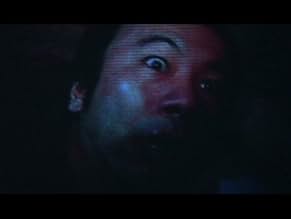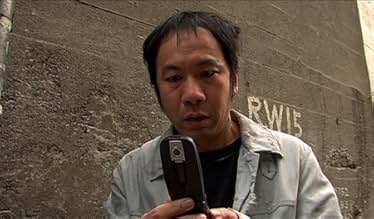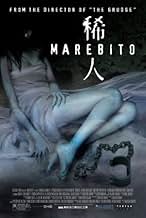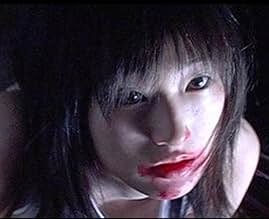PUNTUACIÓN EN IMDb
6,0/10
5,9 mil
TU PUNTUACIÓN
Añade un argumento en tu idiomaA fear-obsessed freelance cameraman (Shinya Tsukamoto) investigates an urban legend involving mysterious spirits that haunt the subways of Tokyo.A fear-obsessed freelance cameraman (Shinya Tsukamoto) investigates an urban legend involving mysterious spirits that haunt the subways of Tokyo.A fear-obsessed freelance cameraman (Shinya Tsukamoto) investigates an urban legend involving mysterious spirits that haunt the subways of Tokyo.
- Dirección
- Guión
- Reparto principal
- Premios
- 2 premios y 1 nominación en total
Reseñas destacadas
Marebito starts out with an interesting premise, but somewhere along the way the movie falls apart.
A camera man captures a man in the subway committing suicide by stabbing himself in the eye. The camera man becomes transfixed by the death image of the man and studies the footage with the hopes of finding a clue as to why the man would commit such an act. He surmises that the man has experienced something so terrifying immediately before his death as to render him suicidal. So the camera man ventures into the subway for clues and finds a door that leads even further down into the subway. The beginning part of the film captured my interest.
Too bad.
What the main lead uncovers...actually what he finds beneath the subway...and what unfolds thereafter is incredibly dull. The rest of the film becomes a jumbled mess as the main character tries to rationalize, in his more and more irrational mind, the supernatural events that unfold. But the film looks rushed and uninspired...it does look like it was filmed in two weeks.
I thought Ju-on was creepy and fairly good as a horror film. The director's effort on this film is unfocused and meandering; he even interlaces at points in the film, clumsily I might add, with discussions of philosophy and the supernatural in the hopes, I suppose, of lending the film some gravitas. Is the director trying to be metaphorical and deliberately obtuse? I don't know and I did not care.
Because I found some parts of the film creepy and even innovative, I rate this film: Average.
A camera man captures a man in the subway committing suicide by stabbing himself in the eye. The camera man becomes transfixed by the death image of the man and studies the footage with the hopes of finding a clue as to why the man would commit such an act. He surmises that the man has experienced something so terrifying immediately before his death as to render him suicidal. So the camera man ventures into the subway for clues and finds a door that leads even further down into the subway. The beginning part of the film captured my interest.
Too bad.
What the main lead uncovers...actually what he finds beneath the subway...and what unfolds thereafter is incredibly dull. The rest of the film becomes a jumbled mess as the main character tries to rationalize, in his more and more irrational mind, the supernatural events that unfold. But the film looks rushed and uninspired...it does look like it was filmed in two weeks.
I thought Ju-on was creepy and fairly good as a horror film. The director's effort on this film is unfocused and meandering; he even interlaces at points in the film, clumsily I might add, with discussions of philosophy and the supernatural in the hopes, I suppose, of lending the film some gravitas. Is the director trying to be metaphorical and deliberately obtuse? I don't know and I did not care.
Because I found some parts of the film creepy and even innovative, I rate this film: Average.
I highly suggest seeing this film if you are a fan of Shimizu's works. Apparently it was filmed before Ju-On, in only eight days. This shows what a master filmmaker can do in such a short time. This movie will make you feel very uncomfortable and extremely disturbed. It is about a camera man who wants nothing more than to feel the most extreme fear. He than finds a subterranean lair filled with eerie creatures called Deros, and he finds a girl (or a creature much like a girl) chained to a rock and takes her home to care for her. He attempts to feed her but he finds that the only thing that she'll eat is blood. The only problems I had with it were the shaky camera moves (Blair-Witch style)but since he only made it in eight days...he has an excuse, and it will go to a normal camera to give your eyes a break. Overall a masterpiece in psycho-horror.
7sol-
Also known as 'The Stranger from Afar', this Japanese horror film focuses on a freelance photographer who rescues a naked woman chained to a rock in a subway tunnel; he takes her home, only to discover that she is more animalistic than human with a taste for blood. The film is pretty much as weird as it sounds with little indication of just how much of what occurs is hallucination, imaginary or real. It remains a gripping ride though even when everything cannot be deciphered thanks to a truckload of atmosphere and a genuinely unsettling turn by Tomomi Miyashita as the mysterious woman. Some of the symbolism hits home quite well too with the protagonist viewing himself as a vampire, feeding off filming the misery and pain of others (sort of like Jake Gyllenhaal's character in 'Nightcrawler', but with a moral compass here). The film also taps into some curious territory early on as the protagonist announces a desire to find what caused a man to be so terrified that he committed suicide before his camera lens; some of his soliloquies in this early part of the film bring to mind 'Videodrome' as he equates cameras to the retinas of human eyes. One's mileage with 'Marebito' will no doubt vary depending on one's tolerance for the unexplained and deliberate ambiguity, but it is certainly refreshingly different from most other vampire movies out there.
A strange film by Grudge writer/director Takashi Shimizu.
Shinya Tsukamoto (Ichi the Killer) is consumed with finding out the source of terror that caused a man to stab himself in the eye. He wants to experience the same terror - terror so horrible that it would cause you to want to kill yourself.
He goes underground looking for the beings that inhabit the tunnels under Tokyo and finds a naked girl, who he brings home to live with him. The girls is more animal than human and he kills to provide her blood rather than give her his own blood, which she wants.
It is not certain throughout whether he is going mad or finding what he is searching for. He even tries to escape, but resumes the search until he finally succumbs to the terror.
Despite the shaky camera work, which some like, but which distracts me, it was a fascinating look at terror and certainly a film that contains much more than available at first glance. A blend of mysticism and horror, it is a worthy view for fans of Japanese horror.
Shinya Tsukamoto (Ichi the Killer) is consumed with finding out the source of terror that caused a man to stab himself in the eye. He wants to experience the same terror - terror so horrible that it would cause you to want to kill yourself.
He goes underground looking for the beings that inhabit the tunnels under Tokyo and finds a naked girl, who he brings home to live with him. The girls is more animal than human and he kills to provide her blood rather than give her his own blood, which she wants.
It is not certain throughout whether he is going mad or finding what he is searching for. He even tries to escape, but resumes the search until he finally succumbs to the terror.
Despite the shaky camera work, which some like, but which distracts me, it was a fascinating look at terror and certainly a film that contains much more than available at first glance. A blend of mysticism and horror, it is a worthy view for fans of Japanese horror.
First off, I hated Ju-On. I thought it was derivative garbage of the J-horror variety (most J-Horror, which many American's think is "cult", is the equivalent of teen slasher flicks in their respective countries). That said, I was expecting nothing from this film. Instead, I got a Japanese David Cronenberg film, for all intents and purposes. This film would make an excellent companion piece to Cronenberg's Videodrome.
Both deal with technology and alienation in an urban setting. While in Videodrome it's the proliferation of mass media that causes the protagonists reality slip, here it's the creation of such media. The main character is a freelance videographer who makes a living filming the horrible things that people do to each other (and themselves) in the crowded yet isolated world of the big city. He eventually comes to understand that nothing is more cruel than what he does. He is, in a figurative sense, a vampire. He sucks the blood of the living into his lens, and thrives off the rewards. But he is lost.
Then he meets...a girl? A creature? A vampire? A hallucination? The fact that she has no recognizable emotion or attachment, and lives only to feed on the blood of people is a projection of what he is so ashamed of.
This film really gets into the feel of alienation (much the way "Clean, Shaven" and Cronenberg's "Spider" did) and makes you feel the way the populace who views his videos do. Disturbed, but secretly glad and thrilled that misery was put on film.
Which leads me to the presentation. Many have griped about the Digital Film approach, which, as most cinephiles know, leads to a harsh lighting scheme and stark contrasts- none of the lushness of film- and jerky movement feel. Shimizou could have easily done this on film if he had wanted to, but instead, I feel, made a choice to use digital...it's the same format that his protagonist records horrible images on. One turn deserves another. I enjoyed this aspect, as the presentation aspect of a film is rarely intrinsic to both the style and subtext of the film.
That said, it's not entirely successful. A few scenes could have used better FX work or shot choice/editing, but, hey, he shot this on the fly in 8 days, on his way to make another J-Horror "scary-kid" schlockfest. This film shows he is more capable than that. Fans of J-horror may want to avoid this, whereas if, like me, you're a fan of shock-cinema and narrative surrealism (Lynch, some Cronenberg, you) may enjoy this.
Both deal with technology and alienation in an urban setting. While in Videodrome it's the proliferation of mass media that causes the protagonists reality slip, here it's the creation of such media. The main character is a freelance videographer who makes a living filming the horrible things that people do to each other (and themselves) in the crowded yet isolated world of the big city. He eventually comes to understand that nothing is more cruel than what he does. He is, in a figurative sense, a vampire. He sucks the blood of the living into his lens, and thrives off the rewards. But he is lost.
Then he meets...a girl? A creature? A vampire? A hallucination? The fact that she has no recognizable emotion or attachment, and lives only to feed on the blood of people is a projection of what he is so ashamed of.
This film really gets into the feel of alienation (much the way "Clean, Shaven" and Cronenberg's "Spider" did) and makes you feel the way the populace who views his videos do. Disturbed, but secretly glad and thrilled that misery was put on film.
Which leads me to the presentation. Many have griped about the Digital Film approach, which, as most cinephiles know, leads to a harsh lighting scheme and stark contrasts- none of the lushness of film- and jerky movement feel. Shimizou could have easily done this on film if he had wanted to, but instead, I feel, made a choice to use digital...it's the same format that his protagonist records horrible images on. One turn deserves another. I enjoyed this aspect, as the presentation aspect of a film is rarely intrinsic to both the style and subtext of the film.
That said, it's not entirely successful. A few scenes could have used better FX work or shot choice/editing, but, hey, he shot this on the fly in 8 days, on his way to make another J-Horror "scary-kid" schlockfest. This film shows he is more capable than that. Fans of J-horror may want to avoid this, whereas if, like me, you're a fan of shock-cinema and narrative surrealism (Lynch, some Cronenberg, you) may enjoy this.
¿Sabías que...?
- CuriosidadesTakashi Shimizu shot the film in just eight days, between the production dates for La maldición (The grudge) (2002) and its remake, El grito (2004).
Selecciones populares
Inicia sesión para calificar y añadir a tu lista para recibir recomendaciones personalizadas
- How long is Marebito?Con tecnología de Alexa
Detalles
Taquilla
- Presupuesto
- 5.000.000 JPY (estimación)
- Recaudación en Estados Unidos y Canadá
- 13.983 US$
- Fin de semana de estreno en EE. UU. y Canadá
- 3852 US$
- 11 dic 2005
- Recaudación en todo el mundo
- 107.259 US$
- Duración1 hora 32 minutos
- Color
- Relación de aspecto
- 1.85 : 1
Contribuir a esta página
Sugerir un cambio o añadir el contenido que falta

Principal laguna de datos
By what name was Seres extraños (2004) officially released in Canada in English?
Responde

























